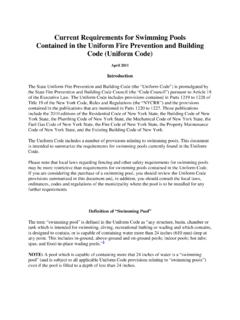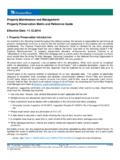Transcription of Cartilage Repair Center
1 Cartilage Repair Center Tom Minas, MD, MS 850 Boylston Street, Suite 112 Andreas Gomoll, MD Chestnut Hill, MA 02467 Courtney VanArsdale, PA-C P: 617-732-9967 Lindsey Oneto, PA-C F: 617-732-9272 (Minas) / -9730 (Gomoll) What is a Patellofemoral Replacement? A patellofemoral replacement is a surgical procedure used to treat patients with bone on bone osteoarthritis of the patellofemoral joint. This is the joint surface between the knee cap (patella) and the end of the thigh bone (femur). Who is a candidate for a Patellofemoral Replacement? Patellofemoral replacements are an artificial resurfacing of the patellofemoral joint used to treat patients with isolated bone on bone osteoarthritis of the patellofemoral compartment.
2 Patients with patellofemoral arthritis often present with symptoms of anterior knee pain that is worse with climbing stairs and sitting for prolonged periods of time. Patients will also likely experience a crunching or grinding sensation when doing stairs or standing from a seated position. Patellofemoral replacements are most commonly performed in women in their early to mid 40 s through their mid 50 s. We do however; perform this procedure in other patient populations based on medical necessity. In order to determine whether or not you are a candidate for a patellofemoral replacement your surgeon will first obtain plain x-rays to assess areas of bone on bone osteoarthritis. Your surgeon my then have you get an MRI to ensure that the other areas of your knee are normal.
3 If there are any irregularities in the other compartments of your knee you may have to discuss alternate treatment options with your surgeon. What will happen during my surgery? Your surgery will be performed using either a general anesthetic or a spinal anesthetic depending on you and your surgeon s preference. During your surgery your surgeon will make an open incision along the front of your knee running up and down your leg. Through this incision your surgeon will be able to access the damaged area of your joint. The femoral side of your knee will be resurfaced with a metal plate made from cobalt chrome. The back side of your patella will be resurfaced with a button made of polyethylene plastic. Both of these components are held in place using cement.
4 Once the cement is hardened and your implant is well fixed your surgical incision will be closed. This will be done using all subcutaneous or dissolving stitches. This means that you will not have any stitches that need to come out. What can you expect post-operatively after a Patellofemoral Replacement? When you awake from surgery depending on your surgeon you may have a brace on your leg that will keep your leg straight. It will be important for you to wear this brace at all times when you are up and about. You do not have to wear your brace to sleep. You will also be given crutches. You will be able to fully weight bear on your operative leg immediately following surgery however, it is a good idea to use your crutches for support as your muscles will be weak following surgery.
5 You will use your crutches anywhere from 3-6 weeks depending on your muscle strength. Depending on your surgeon and how you are feeling you will spend anywhere from 1-3 nights in the hospital. Do plan on spending at least one night. This is in order to make sure that you are comfortable and that your pain is well controlled. This time in the hospital also allows you to also meet with physical therapy and get some early exercise and crutch training. You will begin working with a physical therapist in the first few days following surgery. You can elect to have a visiting physical therapist come to your home for the first few weeks or you may make arrangements at an outpatient physical therapy office. After surgery you will also be on a blood thinning medication called Coumadin.
6 This is done as a preventative measure for all of our patients to help prevent blood clots following surgical intervention. This will be managed by the Brigham and Women s anticoagulation clinic. You will be required to take this medication for a period of 3 weeks time. When you go home from the hospital a visiting nurse will be coordinated for you. Your visiting nurse will come visit you at home once or twice per week to draw your blood. These blood draws are important to managing your dosage of Coumadin. How will my pain be controlled after surgery? Immediately following surgery during your inpatient stay your pain will be controlled using IV pain medication. During your inpatient stay one of the goals of your care will be to transition you from IV pain medication to oral pain medication.
7 This is often achieved by day one or two after surgery. You will be sent home from the hospital with a prescription for oral pain medication to be filled at your local pharmacy. The most commonly prescribed post-op pain medications include Oxycodone, Dilaudid, or Vicodin. Most patients will require regularly scheduled doses of pain medication (every 4-6 hours) for the first two to three weeks. Following week three you will begin to decrease your pain medication use to prior to physical therapy and prior to bedtime. Most patients will not require any pain medication past week 6-8. You will be provided with detailed instructions on how to obtain pain medication refills from your surgeon s office. This information will be provided to you with your surgical packet once a surgical date has been scheduled.
8 It is important to know how to obtain your pain medication refills appropriately and in a timely manner. When will I follow-up with my surgeon after surgery? Your first post-operative visit will be with your surgeon s Physician Assistant. This appointment will take place 2 to 3 weeks after your surgery. This appointment is critical for checking your incision healing and range of motion as well as to answer any questions you may have in the first few weeks following surgery. You will then follow-up with your surgeon 6 weeks after surgery, 12 weeks after surgery, 6 months after surgery, and one year after surgery. After your first year you will follow with your surgeon on a yearly basis. What restrictions will I have following this procedure?
9 Once you have fully recovered from your surgery your only restriction will be in regards to impact loading activities. You will not be permitted to run or participate in jumping activities after a patellofemoral replacement. This is a lifelong restriction as your implant is a mechanical part and excessive pounding activity may cause the implant to fail prematurely. You will still be able to be very active with following surgical intervention. Approved activities include things such as walking, swimming, biking, elliptical trainer, golf, doubles tennis, hiking, skiing, and skating. FAQ s How do I get insurance approval for surgery? Your insurance approval will be handled by your surgeon s administrative assistant. Often you do not need to do anything but wait for the administrative assistant to contact you to let you know you have been approved.
10 In some instances appeals need to be made to your insurance company for denial of services, if this is the case the administrative assistant will contact you and instruct you on how to proceed. How long is my insurance approval good for? Most insurance approvals are good for one calendar year from the date of approval. When will I start physical therapy? You will start physical therapy beginning the day after surgery in the hospital this will be continued once you are discharged either on an in home basis or at an outpatient clinic. What will I do during physical therapy? The primary goal of physical therapy is to initially increase ROM so that you do not get stiff following surgery. You will then begin to work on increasing strength after surgery.





